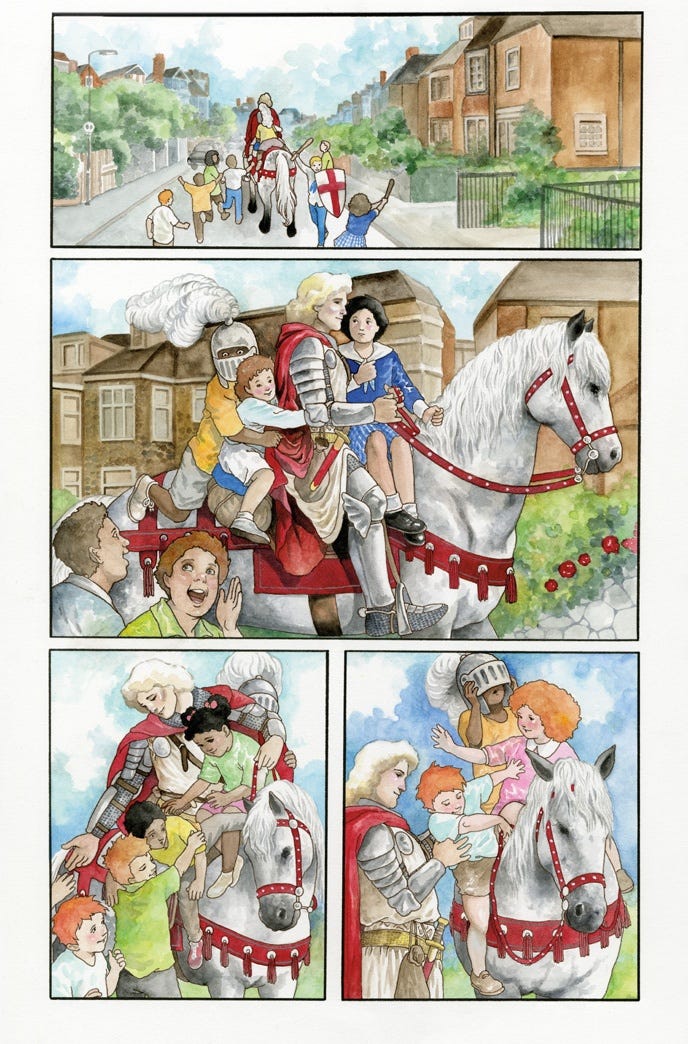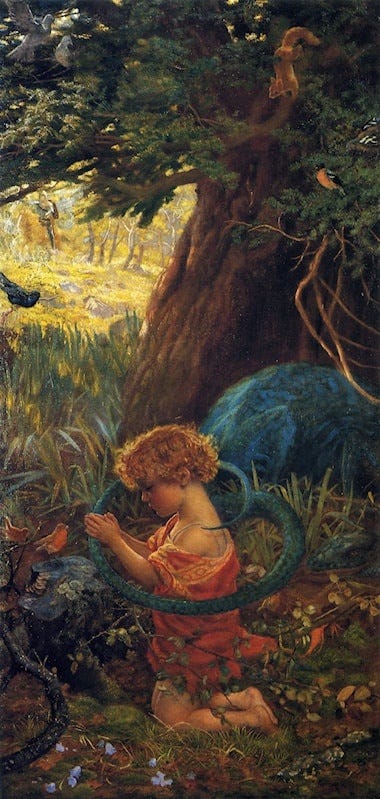The Secret Language of a Page of Chivalry: The Pre-Raphaelite Connection.
Totes Meta
Adapting Neil Gaiman’s Chivalry is a decades-long dream fulfilled. The story as text can be enjoyed on multiple levels, and so can the art. You look at the pages and see the pretty pictures, but the pictures also have meta-textual meaning. Knowing this secret language adds to the experience.
Some people pick up the references quickly, but I’ll share with you some more of what’s going on under the surface.
In Ye Olden Days of Art Making, most painters made pictures that contained visual narrative cues. Flowers in a picture might be heraldic signs that signaled political affiliations, or could indicate purity, anger, or love. Purple was the color of kings. A dog in a picture might represent faithfulness, and butterflies could represent the soul.
There are Pre-Raphaelite paintings with so many symbols and ideas in them that you need a deep working knowledge of Victorian and Edwardian social mores to understand what’s going on.
For example, Ford Madox Brown’s Work, a painting which took some 13 years to complete, was first exhibited in 1865 with a catalogue explaining all its symbols and elements. There is nothing in that picture that doesn’t mean something.
I brought some of that visual meta-textual sensibility to Chivalry, (and I’ve written about the symbolism and meanings in the work in other essays.)
I also brought into the work direct Pre-Raphaelite art references.
From 1868-1870, Sir Edward Coley Burne-Jones created four paintings illuminating the tale of Pygmalion and Galatea, entitled Pygmalion and the Image, and wrote a poem with each line titling one painting:
The heart desires
The hand refrains
The godhead fires
The soul attains.
A perfect little poem for Chivalry, and I think of it often when some people present me with what I think is a very strange question: why didn’t Galaad just take the Holy Grail from Mrs. Whitaker?
It kind of breaks my heart that people would even ask that.
Burne-Jones painted two versions of this series of which this is the second.
In the first panel of this page, Sir Galaad kneeling before the Grail is derived from the figure of Pygmalion kneeling before Galatea: The Soul Attains.
Sir Galaad’s restraint even in the face of his greatest desire makes him worthy of his prize.
There are two Pre-Raphaelite references in this page, the most obvious being in panel 2: it’s Sir John Everett Millais’s 1857 work A Dream of the Past: Sir Isumbras at the Ford.
The painting was very poorly received on first exhibition, compelling Millais to redo significant portions of it. It was caricatured and ridiculed, and then ended up becoming influential and popular, and isn’t that the way it goes.
That’s an art career in a nutshell, really.
The Sir Isumbras image also influenced John Tenniel’s illustrations for the Lewis Carroll Alice in Wonderland novels.
Sir Isumbras derives from a 13th century Medieval romance poem about a good knight whose pride causes him to fail in his Christian duty. He is presented with a series of difficult challenges before he can find happiness again, reunite with his family, and be forgiven his sins. The painting by Millais is based less explicitly on the poem than it is on a later parody of the poem. (It’s complicated.)
My using Sir Isumbras as the base for the shot of Galaad with the children is obvious here. In the Millais painting, Sir Isumbras carries a woodcutter’s children across the ford. In Chivalry, Sir Galaad carries the children of Mrs. Whitaker’s neighborhood down the street.
While Sir Isumbras spent many years learning humility and Christian duty, Galaad has a long quest to fulfill before he can achieve his goal. And on the way to that goal, he’s humble and nice to children, too.
That the Millais painting was such a huge influence on many a depiction of knighthood over the years made it a perfect reference point here, and the story behind both the painting and the poem give it further layers of meaning.
The next panel has a far less obvious reference, but the source is Arthur Hughes’s painting The Rescue.
Arthur Hughes is one of the lesser-known Pre-Raphaelites, but his art is widely seen and influential. He’s certainly been a big influence on me, as many of his paintings appear again and again in Arthuriana references, as he was a prolific King Arthur picture tale teller.
The Rescue (1907-1908) was originally part of a diptych which was separated and sold back in the 1920’s. His style was becoming unpopular by the time Hughes painted the work, and little is known about this work except that one panel was in the collection of Andrew Lloyd Webber at some point. Maybe still is. Dunno.
Anyway, the diptych depicts a little child kneeling in prayer menaced by a dragon in one panel, and in the next, safely trotting away with a knight on horseback. I like that this is a diptych, a kind of proto-comic art form common in medieval religious art, so this was perfect to use here.
Another reference to Arthur Hughes is in this double page splash from later in the book as Galaad on his quest encounters the Hesperides.
I didn’t set out to reference this Arthur Hughes piece at first, but it’s one of my favorite paintings. When I realized my sketches for this scene kept echoing the Hughes composition, I went with it. The Hughes painting of Galahad is one of the most famous depictions of the character, so it makes me happy to have this referenced in Chivalry.














…Say, wait! Why wouldn't the only Knight of the Round Table so pure of heart as to behold the Sangrail just push the old lady out of the way and grab it? Are there moral implications or something;)
The sophistication of your work is just lost on some people, but we already knew that from the "Galaad missing H printing error" thing, I guess.
Great essay, makes me wish for a Chivalry: Director's Commentary edition!
Wonderful, Colleen.